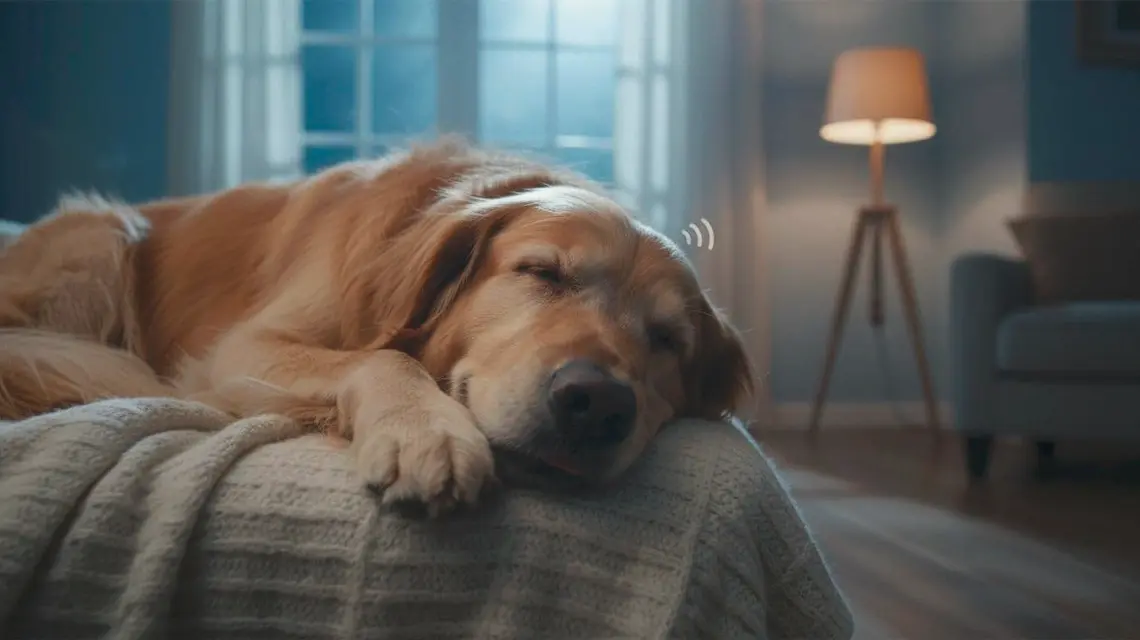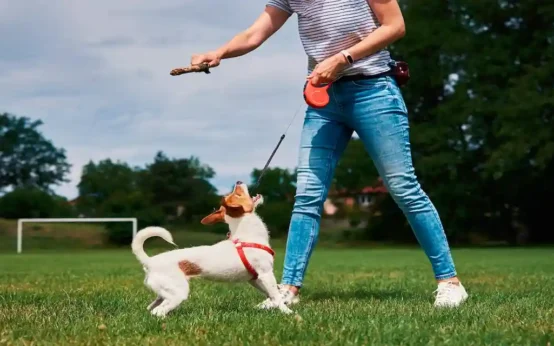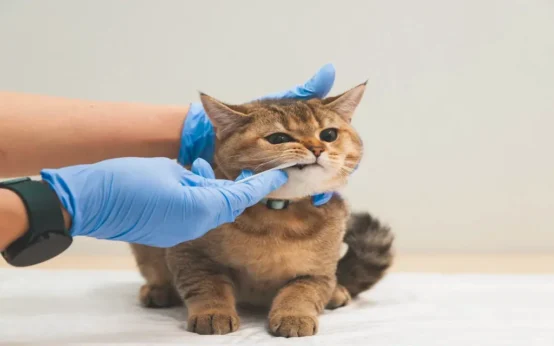You hear it at 2 a.m., that soft rumble of dog snoring in sleep coming from the foot of the bed. Sometimes it is cute. Other times it is loud enough to wake the house. Light snoring can be normal for many dogs, but new, very loud, or worsening snoring can point to a health issue.
This guide explains why dogs snore, what counts as harmless, and what signals a problem. You will learn common causes, simple fixes you can try at home, and when to call your vet. Keep an eye on your dog as you read. Notice patterns, positions, sounds, and energy levels. Small details help you make smart choices for your pup’s comfort and safety.
Why dogs snore in sleep and when it is normal vs not
Snoring happens when air has a rough path through the nose, mouth, or throat. As your dog breathes in or out, soft tissues vibrate. This makes that familiar rumble. Think of air like wind moving past loose leaves. If the path is smooth, there is little noise. If the path is tight or the tissue is floppy, the sound builds.
Sleep stages and position matter. During deeper sleep, muscles relax, including those around the throat. A dog on its back can shift the tongue and soft palate in a way that narrows the airway. On the side, airflow is usually better. After a long, active day, dogs may sleep deeper and snore more.
Harmless snoring tends to be soft and steady. It often shows up after a long play session, in winter when air is dry, or when your dog sleeps upside down in a silly pose. It also shows up in some breeds with shorter snouts.
Warning signs suggest a different story. If snoring is new, very loud, or paired with odd breathing, it may be time to act. Watch for energy changes, mouth breathing at rest, or snoring that wakes your dog. If your dog struggles to breathe or seems anxious during sleep, call a vet.
Key points to remember:
- Light, steady snoring in certain positions is often normal.
- Loud, irregular snoring with gasps or pauses is a red flag.
- Patterns matter. New or worsening snoring deserves attention.
What snoring is and how it sounds in dogs
Snoring is the sound of air vibrating soft tissues in the nose, throat, or mouth during sleep. It can be soft and rhythmic, like a purr, or loud and uneven with snorts. Puppies, adult dogs, and seniors can all snore. What matters most is the pattern. A soft snore a few nights a week is not the same as nightly thunder that keeps everyone up.
Normal reasons dogs snore in sleep
Common harmless causes include sleep position, especially lying on the back with the head flat. Deeper sleep after a busy day can also bring more noise. Temporary stuffiness from dust or a recent romp in the yard may play a role. Winter’s dry air can add a little rasp. Some breeds have mild snoring even when healthy. Track frequency and volume so you notice changes early.
Red flags that snoring is not normal
Watch for gasping, choking sounds, or long pauses in breathing. Blue or gray gums, heavy daytime sleepiness, or sudden behavior changes are serious signs. New, very loud, or fast-worsening snoring needs attention. One-sided noise or discharge from one nostril can also signal trouble. If you are unsure, record a short video to share with your vet.
Health causes of loud dog snoring you should check
Not all snoring is simple. Health factors can narrow the airway or inflame tissues, which increases noise. Sometimes there is a short-term trigger, like a dust-filled room. Other times there is an ongoing issue, like excess weight or a structural problem in the nose and throat. More than one factor can stack. For example, seasonal allergies plus mild weight gain often make snoring worse.
Airway irritation from allergens or smoke can swell tissues. Swelling makes air push through a smaller space, so vibrations get louder. Dental problems can affect the sinuses and the mouth, adding another source of noise. Flat-faced breeds start with narrower paths, so even a little swelling or heat can cause a big change.
Look for signs that cluster. A dog that snores, tires quickly on walks, and mouth breathes at rest might point to fitness, heat, or airway obstruction. A dog with one-sided discharge and face pawing may have a sinus or dental issue. A pup that snores only in winter may be reacting to dry air or indoor heating. These clues help you choose the right next step.
Allergies, irritation, and swelling in the airway
Pollen, dust, smoke, mold, scented sprays, cleaning fumes, and dry indoor air can inflame the nose and throat. This is common in spring and fall, and during cooler months when indoor heating dries the air. Signs include sneezing, itchy or red eyes, clear or cloudy nasal discharge, and louder snoring at night. Reduce irritants. Keep the sleeping area clean and low in dust. Place the bed away from air vents and scented candles.
Weight gain and low fitness
Extra fat around the neck and throat narrows the airway, especially when a dog lies on its back. You might hear loud, steady snoring and more snorting when your dog is excited. Getting tired fast on walks or avoiding stairs can also signal low fitness. Slow, steady weight loss helps. Daily activity, portion control, and fewer high-calorie treats make a big difference.
Flat-faced breeds and narrow airways
Bulldogs, Pugs, Boston Terriers, and Shih Tzus have short noses, long soft palates, and often narrow nostrils. These features create a tighter airway that can snore, snort, and overheat more easily. A vet can help manage risks with guidance on weight, activity, and sometimes surgery to improve airflow. Heat and heavy exercise make symptoms worse, so plan rest breaks and cool spaces.
Infections, dental problems, and growths
Sinus infections, kennel cough irritation, and bad teeth or gum disease can increase snoring. The nose and mouth are linked, so pain or swelling in one can affect the other. Nasal polyps or masses may block airflow on one side. Signs include fever, foul breath, colored or one-sided nasal discharge, face pawing, or sudden new snoring. These cases need prompt vet care.
How to stop or reduce dog snoring at home
You can make simple changes that help your dog breathe easier at night. Start small, then adjust as you learn what works. Keep the bedroom clean and calm. Focus on better sleep posture, cleaner air, steady routines, and a healthy weight. Use common sense tools you may already have. Avoid human medications unless your vet approves them.
Bedding, air quality, and daily habits all play a role. Fix the easy things first, like elevation and humidity. Then build a plan for weight and fitness. Track what you try, when you try it, and what changes you hear or see. Those notes are gold if you need a vet visit later.
Fix sleep position and bedding for better airflow
- Use a supportive bed with a slight head and neck lift. A pillow or folded blanket under the head can help.
- Encourage side-sleeping with a donut or bolster bed that hugs the body.
- If snoring spikes on the back, gently guide your dog to roll to the side.
- Wash bedding weekly to cut dust and dander.
Cleaner air and the right humidity
- Place a HEPA air purifier near the sleep area and vacuum floors and rugs often.
- Keep the bedroom smoke-free, and limit scented candles or sprays near your dog.
- Aim for 40 to 50 percent humidity during dry seasons with a quality humidifier.
- Change purifier and HVAC filters on schedule.
Weight management and daily movement
- Use a vet-approved feeding plan with measured meals. Stick to it.
- Swap high-calorie treats for dog-safe veggies like carrots or green beans.
- Add daily walks that fit your dog’s fitness and weather. Short and steady beats rare long sessions.
- Increase activity gradually. Watch for heavy panting or stress and ease up if needed.
Safe products to try, and what to avoid
- Consider a pet-safe saline nasal spray to moisten dry passages.
- Ask your vet about allergy support that fits your dog’s needs.
- Use cooling mats in hot weather to reduce heat stress at night.
- Avoid human decongestants, antihistamines, or essential oils unless your vet says they are safe.
- Skip DIY gadgets that claim to stop snoring. Comfort and safety come first.
When to see a vet for dog snoring in sleep
Clear decision points help you act with confidence. If snoring is mild and fits normal patterns, try home steps and monitor. If snoring is new, very loud, or paired with other symptoms, call your vet. You will feel better having a plan. Early care often costs less and reduces stress for both of you.
Before your visit, write down when the snoring happens, how loud it is, and what position your dog sleeps in. Note exercise tolerance, daytime energy, and any nasal discharge or cough. A short phone video of your dog sleeping is extremely helpful. Bring details about diet, treats, and any changes at home.
Signs you should call the vet now
- Gasping or choking sounds, long breathing pauses, or struggle to breathe
- Blue, gray, or very pale gums
- Fainting or collapse
- Very loud snoring that starts suddenly
- Bleeding from the nose or one-sided blockage
- Snoring with weight loss, cough, fever, or low energy
If you are in doubt, call your clinic or an emergency vet for guidance.
What the vet might do and check
Expect a review of your dog’s history, a nose and throat check, and careful listening to the lungs and heart. Tests may include X-rays, an airway scope, dental exam, or allergy testing. Your sleep videos help show patterns the vet might not witness in a short visit. Flat-faced dogs may be referred to a specialist for airway evaluation and treatment planning.
Treatment options and realistic outcomes
Common treatments include allergy control, dental work, antibiotics for infections, weight loss plans, and medication for swelling. For severe airway blockage in flat-faced breeds, surgery can improve airflow and comfort. Results vary by dog and cause. Some dogs will always snore a little, but you can still improve comfort, sleep quality, and safety.
Costs, planning, and how to prepare
Set a budget range and ask for clear estimates, including must-do items and optional steps. Bring a symptom journal, feeding details, videos of snoring, and a list of home fixes you tried. Ask about aftercare, activity limits, and follow-up visits. Clear communication avoids surprises and helps you choose what is best for your dog.
Conclusion
- Light, steady dog snoring in sleep can be normal, especially by position or season.
- Health causes include allergies, weight gain, flat-faced airway limits, infections, and dental issues.
- Home fixes help: better sleep position, cleaner air, steady humidity, and healthy weight.
- Call your vet for new, very loud, or worsening snoring, or if you see breathing trouble or other symptoms.
Start with one small change tonight, like a side-sleeping bed and cleaner air. Keep notes, watch patterns, and reach out to your vet if you spot red flags. Your dog wants rest, you want quiet, and with the right steps, both are within reach.
Related post: Can a Dog Eat Cat Food?
Dog Snoring in Sleep FAQs:
Is dog snoring normal?
Often yes. Many dogs snore now and then. Short-nosed breeds snore more due to narrow airways. Mild, steady snoring without other symptoms is usually harmless.
Why do some breeds snore more than others?
Brachycephalic breeds, like Pugs and Bulldogs, have short skulls and narrow nasal passages. Their soft palate and tongue can crowd the airway. This makes snoring more likely.
Can sleep position cause snoring?
Yes. Back sleeping lets the tongue fall back, which narrows the airway. Side sleeping or a slightly raised head often reduces snoring.
Does weight affect snoring?
Extra neck and throat fat can press on the airway. Overweight dogs snore more and may breathe harder. A vet-guided weight plan often helps.
Could allergies make my dog snore?
Yes. Pollen, dust, smoke, or mold can inflame nasal tissues. Swollen passages vibrate and cause snoring. Cleaning bedding, using a HEPA filter, and vet-approved meds can help.
When should I worry about snoring?
Call your vet if you see labored breathing, choking sounds, long pauses in breathing, blue or gray gums, fainting, loud new snoring, nasal discharge, or daytime fatigue. These can signal airway or lung problems.
Can dogs have sleep apnea?
It can happen, mostly in short-nosed breeds. Signs include loud snoring, gasping, and pauses in breathing with daytime sleepiness. This needs a vet exam and a plan.
Could a cold or infection be the cause?
Yes. Kennel cough, nasal mites, fungal infections, or a foreign object can block airflow. Look for sneezing, discharge, cough, or fever. See your vet if symptoms last.
Will a humidifier help?
Often. Dry air irritates the nose and throat. A cool mist humidifier by the bed can ease snoring. Clean it often to prevent mold.
Do older dogs snore more?
Often they do. Muscle tone in the throat can weaken with age. Check for dental disease, masses, or laryngeal issues if snoring starts or worsens.
Are there safe home tips to reduce snoring?
- Keep your dog at a healthy weight
- Wash bedding weekly and vacuum often
- Use a HEPA filter if allergens are a problem
- Switch to side sleeping or elevate the head slightly
- Avoid smoke, strong scents, and dusty rooms
- Keep the room cool and slightly humid
Can I give my dog antihistamines?
Only with vet guidance. Some dogs can take simple antihistamines for allergies. Doses vary by weight and health. Never give decongestants for people.
Could dental or mouth problems cause snoring?
Yes. Infected teeth, oral masses, or an elongated soft palate can narrow the airway. Regular dental checks help catch issues early.
Why does my puppy snore?
Puppies can snore due to soft tissues and deep sleep. Gentle, steady snoring is common. If you hear gasping, see discharge, or notice poor growth, call your vet.
Is snoring painful or harmful to my dog?
Simple snoring is not painful. If oxygen dips or breathing is hard, it can strain the heart and lungs. Watch for effort, color change, or behavior changes.
Do short-nosed dogs need surgery for snoring?
Sometimes. Surgery for brachycephalic airway syndrome, such as trimming the soft palate or opening nostrils, can improve airflow. A board-certified surgeon should assess the risks and benefits.
Could recent anesthesia make snoring worse?
Temporarily, yes. Throat irritation after intubation can lead to snoring for a few days. If it persists or breathing seems hard, contact your vet.
Should I record the snoring for my vet?
Good idea. A short video that captures the sound, sleep position, and breathing pattern helps your vet assess severity and triggers.
When is an urgent vet visit needed?
Go now if your dog is struggling to breathe, has blue or pale gums, collapses, has repeated pauses in breathing, or cannot settle due to breathing trouble. These are emergencies.




 Dog Trick Training for Beginners
Dog Trick Training for Beginners  Gingivitis Cats Symptoms Every Pet Parent Should Know
Gingivitis Cats Symptoms Every Pet Parent Should Know  How to Make Dog Cookies at Home
How to Make Dog Cookies at Home  Wet Food or Dry Food for Cats?
Wet Food or Dry Food for Cats?  What Is the Healthiest Hamster Breed for Your Home?
What Is the Healthiest Hamster Breed for Your Home?  Cat Food Intolerance Symptoms: How To Spot Them Early
Cat Food Intolerance Symptoms: How To Spot Them Early